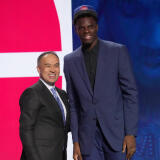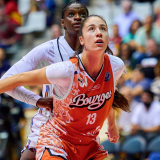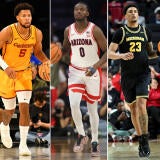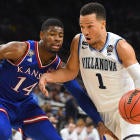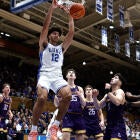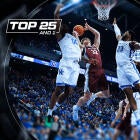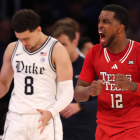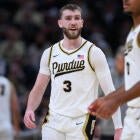NBA Draft 2018: These 7 sleepers could make any team that passes on them look bad
Almost every year there's at least one second-round gem who goes on to outplay his draft position
Steve Kerr, Draymond Green, Doc Rivers, Kyle Korver, Danny Ainge, DeAndre Jordan, Marc Gasol, Trevor Ariza, Danny Green, Malcolm Brogdon, Chandler Parsons, Manu Ginboli, Paul Millsap.
All second-round picks in the NBA Draft. Some are on their way to the Hall of Fame.
Most second rounders wind up living an NBA journeyman's route. Some swing in for a cup of coffee. But every team is hoping their months -- or years, in the cases of many second round prospects -- of scouting pay off with the coveted sleeper pick. There is no science and there is no formula to figure out which type of player winds up being undervalued at the start of his career. If there were, stories like this wouldn't be an option.
As we look to the 2018 draft, here are my best estimations on those who are projected to be picked in the second round but who do have potential to wind up as top-20 players from this draft a few years down the road.
1. Jalen Brunson, Villanova
I have to include him, and I have to start with him. College basketball and the NBA are different games, yes, but I reject the cynical opinion that they are "different sports." Nevertheless, that sort of thinking is how you wind up getting a two-time national champion point guard who swept national player of the year honors and proved to be one of the best players in Villanova history being slotted in the back half of the draft.
Within three years, Brunson is likely to establish himself as one of the 20 best players from this draft. I expect him to be starting by 2021, and if you're getting a starting-level player in the second round, that's obviously a sleeper or a steal. He's intelligent and plays with a pace that's malleable. Brunson is confident but not cocky with a good build, who knows how to use his feet and almost never makes dumb decisions. Brunson is lacking defensively, but if he wasn't then he'd be a top-15 pick.
Brunson's coming off averaging 18.9 points, 4.6 assists and 3.1 rebounds, but check the overall averages: 59.9 from 2, 40.8 from 3 and 80.2 from the foul line. His statistics make a case on top of the obvious one: You can't deny his feel and intellect for basketball when you watch him play. It's hard to see how he slips past 35 in this draft, but going past 20 is still too much. Still, it's likely to happen. He is the most blatant sleeper candidate of the past five drafts, I think.
2. Trevon Duval, Duke
Duval is such a tough prospect to forecast, but here's the thing: If he hits, he's gonna hit. Duval has top-20 athleticism and the room to grow into a very good NBA player. His shot is broken (relative to NBA standards) and his freshman season reel unequivocally dropped him into the second round. But it would not be a shock to look up in five years and see Duval as one of the top 15 point guards in the NBA. That is the essence of sleeper material. If it happens, the team that picks him could wind up being among the biggest winners of the 2018 draft.
Duval's numbers (10.3 points, 5.6 assists, 49 percent from 2, 29 percent from 3, 63 percent from the foul line) were a harsh drop from his reputation entering Duke. He was going to be the lead point guard who got Duke's offense to elite levels. Well, Duke was elite on O but it was hardly because of Duval.
I like him as a sleeper, even in spite of so many Duke players just kind of existing in the NBA, because of his frame, athletic ability and full-court vision. The NBA game might open him up in a good way. He will take time, though. If he's a sleeper, he'll need at least two years of development, I bet.
3. Melvin Frazier, Tulane
Now we're talking. Out of the American Athletic Conference, Frazier got almost no publicity in his college career. He is no secret in scouting circles, though. He averaged 15.9 points, 5.6 rebounds, 2.9 assists, 2.1 steals and shot 62.3 from 2. From 3-point range, he flirted with a 40-percent clip.
You put those elements into a modern NBA athlete that has a 7-foot, 1.75-inch wingspan as a wing? Enticing. Might even be a sleeper first round choice, though I think he's destined for the second. Most importantly, Frazier has multifaceted defensive capability. So often when we look at players in the second round, we're looking how they might fit in an offense or contribute in parceled ways. But if you can play defense well against the best in the world? It's a stock-changer.
Don't make the mistake of thinking that just because a player came from a bad team, or that you never saw him on TV, that he's not a good pick. Frazier's best days are ahead of him.
4. Shake Milton, SMU
Like Frazier, he has a wingspan (7-0.75) that's alluring compared to his height (a shade under 6-6 in shoes). Milton was an aggressive scorer for the Ponies last season, averaging 18.0 points and bolstered all around by 4.7 boards and 4.4 assists. He shot 43.4 from 3-point range.
So, a 3-and-D? Yeah, absolutely. Maybe more. See, he's got a very good dribbling technique and is a fun threat for his willingness to pass despite being a three-level offensive threat whenever he has the ball. He gets to the line and shoots well from the stripe (84.7 percent) once he's there. Milton is a good defender, but someone who's coming off a hand injury. Maybe that's why his stock is a little lower heading into the draft.
Regardless, his skill set is so natural and stable at this point (Milton will be 22 by the time next season starts) that's it's hard to see how he's not consistently on a roster for the first five years of his career. That's the floor, I think. The ceiling is hyper-sleeper territory, wherein he clicks automatically and is competing for a starting spot by Year Two.
5.Landry Shamet, Wichita State
The Shockers' best player flirted with the draft in 2017. He's right to be leaving this year for good, though. Bonus for Shamet right off the bat: He was transitioned from combo guard to point guard and became a better player after that happened. Adaptability is a necessary component to any second round pick's portfolio. At 6-5, he's a tall point guard with a good shooting stroke and vision that comes through in every aspect: full-court, transition, half-court and in-the-post.
He can play off the ball if needed, and I think that's going to be part of his role to start his career. Shamet averaged 14.9 points, 5.2 assists, 3.2 and had a 127.5 offensive rating, per KenPom.com, which made him among the most efficient guards in college basketball. Though he comes from Wichita State, like Fred VanVleet and Ron Baker, he's a much different player from either of those two, who themselves had few things in common as pro prospects.
Fit might be key for Shamet. I don't expect immediate returns, but if we look up in six seasons to see him averaging 12/6/4, that wouldn't be out of place. Sleepers often need some time to wake up.
6. Allonzo Trier, Arizona
Depending on the mock, Trier is either a late second-round pick or not included at all. He had a strong junior season (and good enough college career) to earn consideration. The Arizona lead guard averaged 18.1 points, 3.2 assists, 3.0 rebounds and shot a tremendous 62 percent from 2-point range. Any time a guard is clipping the 60-percent point from 2 while taking a fair share of 3-pointers, it's a great sign. Trier, for what it's worth, shot 38 percent from 3-point range last season and averaged 5.6 trey attempts.
I like him as a sleeper particularly because of where he is (or isn't) projected. If he goes undrafted, his agent will have a long line of teams trying to land him right after the 60th pick is in. If he is picked, he'll line up as a more promising offensive player than at least 20 of the guys taken in the second round. And it's not just that he can score: I think he's a good decision-maker with his shots, and I think he's built to have the best range on his 3-pointer outside of any guard in this draft named Trae Young.
Deandre Ayton was Arizona's best and most important player last year, but Trier seems to been pushed too far on the backburner over the past two-plus months.
7. Gary Trent Jr., Duke
I'm going with two Duke players here, which brings credence to what Wendell Carter Jr.'s recent comments alluded to. (In short, that Duke's players will flourish in the NBA because they'll be given a chance to showcase their talents more effectively than while in college.) Trent's a sleeper choice in this regard: he is going to follow in the footsteps of guys like Reggie Bullock, Doug McDermott, Buddy Hield and Darren Collison. They were drafted in part as great 3-point shooters and continued to be that in the NBA. I don't know if Trent is going to become some dynamic offensive presence, but I'm pretty sure he's going to grow into a player who hits between 41 and 45 percent of his treys.
If he falls to the 40s, there is undeniable value in a player like that in today's NBA. Trent averaged 14.5 points, 4.2 rebounds and shot 40.2 percent from 3-point range last season. He's very good from the foul line (87.6) as well, but how frequently he gets to the line is questionable.
Fortunately for Trent, the shot is not only reliable, the form is great. He has the technical aspect of shooting figured out. His size is good, too. He's an ideal body type for a shooting guard. If he can develop into someone who creates his own shot and brings his game closer to the basket by his third or fourth year, then Trent's ceiling from a scoring standpoint is probably top-three among all consensus second-round projected picks.



